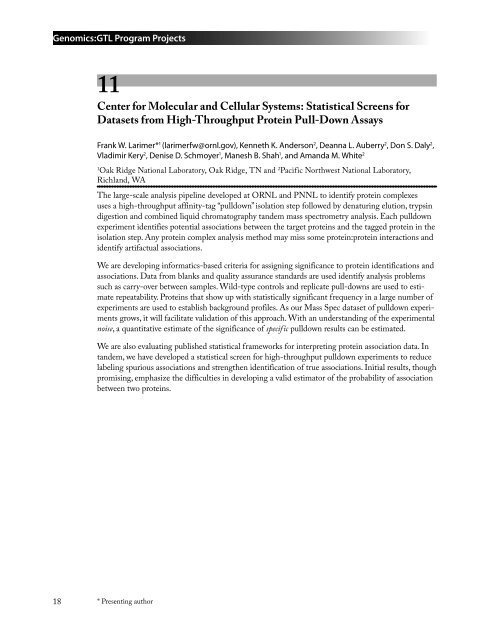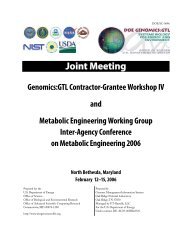2005 gtl abstracts.indb - Genomics - U.S. Department of Energy
2005 gtl abstracts.indb - Genomics - U.S. Department of Energy
2005 gtl abstracts.indb - Genomics - U.S. Department of Energy
You also want an ePaper? Increase the reach of your titles
YUMPU automatically turns print PDFs into web optimized ePapers that Google loves.
<strong>Genomics</strong>:GTL Program Projects<br />
11<br />
Center for Molecular and Cellular Systems: Statistical Screens for<br />
Datasets from High-Throughput Protein Pull-Down Assays<br />
Frank W. Larimer* 1 (larimerfw@ornl.gov), Kenneth K. Anderson 2 , Deanna L. Auberry 2 , Don S. Daly 2 ,<br />
Vladimir Kery 2 , Denise D. Schmoyer 1 , Manesh B. Shah 1 , and Amanda M. White 2<br />
1 Oak Ridge National Laboratory, Oak Ridge, TN and 2 Pacific Northwest National Laboratory,<br />
Richland, WA<br />
The large-scale analysis pipeline developed at ORNL and PNNL to identify protein complexes<br />
uses a high-throughput affinity-tag “pulldown” isolation step followed by denaturing elution, trypsin<br />
digestion and combined liquid chromatography tandem mass spectrometry analysis. Each pulldown<br />
experiment identifies potential associations between the target proteins and the tagged protein in the<br />
isolation step. Any protein complex analysis method may miss some protein:protein interactions and<br />
identify artifactual associations.<br />
We are developing informatics-based criteria for assigning significance to protein identifications and<br />
associations. Data from blanks and quality assurance standards are used identify analysis problems<br />
such as carry-over between samples. Wild-type controls and replicate pull-downs are used to estimate<br />
repeatability. Proteins that show up with statistically significant frequency in a large number <strong>of</strong><br />
experiments are used to establish background pr<strong>of</strong>iles. As our Mass Spec dataset <strong>of</strong> pulldown experiments<br />
grows, it will facilitate validation <strong>of</strong> this approach. With an understanding <strong>of</strong> the experimental<br />
noise, a quantitative estimate <strong>of</strong> the significance <strong>of</strong> specific pulldown results can be estimated.<br />
We are also evaluating published statistical frameworks for interpreting protein association data. In<br />
tandem, we have developed a statistical screen for high-throughput pulldown experiments to reduce<br />
labeling spurious associations and strengthen identification <strong>of</strong> true associations. Initial results, though<br />
promising, emphasize the difficulties in developing a valid estimator <strong>of</strong> the probability <strong>of</strong> association<br />
between two proteins.<br />
18 * Presenting author





